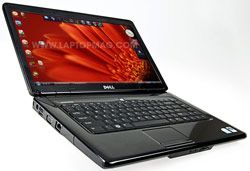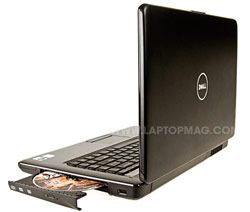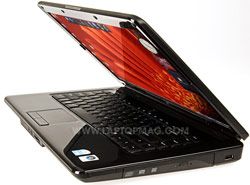Laptop Mag Verdict
Dell's all-purpose notebook offers a bright display, good ergonomics, and helpful software, but multitaskers will want to upgrade the processor.
Pros
- +
Bright 16:9 display
- +
Comfortable keyboard, touchpad, and touch buttons
- +
Loud speakers
- +
Convenient Dell Dock and backup software
Cons
- -
Lacks webcam at this price
- -
No HDMI port
Why you can trust Laptop Mag
With its basic, no-frills design, Dell's Inspiron 15 looks the part of a budget notebook ($499 with E-value code DNDPZU1). Fortunately, it performed better than expected, even keeping pace with higher-end, all-purpose laptops on some tests. At this price, you won't get a webcam (it's available as an upgrade), and this machine lacks an HDMI port. But, for students and families on a budget, the Inspiron 15's combination of decent performance, nice ergonomics, and a bright, 16:9 display make it a sensible pick.
Design
The Inspiron 15 lacks most of the design flourishes you'd expect on a higher-end notebook: You won't find any metal accents, multimedia controls, or glowing LED lights. As basic as the design is, though, it's not unpleasant. We much prefer the matte lid on the Inspiron 15 to a glossy one, though, because it won't pick up fingerprints (black, the color of our unit, is standard; nine other colors and patterns are available on Dell's site, which cost $40 each).
On the inside, almost every component bears a glossy piano-black finish. The keyboard, however, has a matte, textured feel, as does the touchpad. The speaker strip, which stretches across the top of the chassis near the hinge, blends in so well it's easy to overlook.
At 5.8 pounds, the Inspiron 15 isn't light enough to shuttle around campus conveniently, although it's certainly possible. The wide footprint (14.7 x 9.6 x 1.5 inches) also makes carrying it a little cumbersome, although it's not as heavy as other mainstream notebooks, such as the new Gateway NV series, which starts at 6.8 pounds.
Keyboard and Touchpad
In a market full of island-style keyboards, the Inspiron 15's large, close-set keys might seem dated. Nevertheless, they do what they're supposed to: provide a sturdy, comfortable typing experience. With little hands-on time, we scored 81 words per minute on the Ten Thumbs typing test. Soon thereafter, our score rose to 88 words per minute, which is the highest score we've notched on our desktop computer.
The keyboard gets points, too, for not making much noise. The touch buttons are quiet, and we quickly warmed to their tactile feedback, which was neither too stiff nor too gummy. And its textured finish provided just the right amount of friction. For a machine this large, however, we would have expected a slightly taller touchpad than the Inspiron 15's, which measures 1.8 x 3.0 inches.
Ports and Webcam
For its target audience (students and other budget-conscious shoppers), the Inspiron 15's selection of ports is appropriate: Three USB 3.0 ports, VGA out, Ethernet, headphone and mic ports, an ExpressCard/34 slot, and a 7-in-1 memory card reader. These ports are evenly distributed between the notebook's two sides, with the headphone and mic ports and memory card reader placed smartly on the front side (not having ports on the back is always a plus).

Click to enlarge

Click to enlarge
Although the 15.6-inch display will be large enough for many users, we wish the Inspiron 15 had an HDMI port. The lack of a webcam is also disappointing, especially because you'll find this feature on most lower-cost netbooks; you can add one for $25 when configuring your system online.
Display and Audio
Like many consumer notebooks we've reviewed in the past 12 months, the Inspiron 15 has a wide, 16:9 display, whose extra pixels make it ideal for multitasking, as well as for watching movies (for the record: a 16:10 display would have been fine, too). As bright as our display was, our unit did not come with the LED-backlit option (a $25 upgrade).
The display's 1366 x 768 resolution is standard for this screen size. Although very bright, the screen's glossy finish limited our viewing angles: As soon as we pushed the lid forward, the picture began to wash out. When watching a Saturday Night Live clip on Hulu, we had slightly better luck when trying to view it from the sides.

Click to enlargeWhen we watched an episode of Heroes on DVD, the show played smoothly, although when we pressed fast forward a few times to jump chapters, the optical drive took a few seconds to catch up, and the playback stuttered.
The speaker strip is, in a word: loud. Whereas many budget notebooks' speakers are so weak that we usually leave the volume at or close to its maximum, the Inspiron 15's speaker was so loud we didn't feel the need to crank it past its median setting. As for quality, Michael Jackson's "Smooth Criminal" and Santana's "Maria, Maria" sounded somewhat tinny; while not unpleasant, these songs backbeats' sounded more metallic than when we played them on our plastic Apple MacBook.
Performance
Although the Inspiron 15 is available with current Intel Core 2 Duo processors, this configuration comes with a modest 2.0-GHz Intel Pentium Dual Core T4200 CPU. However, it has a generous 3GB of RAM, which booted Windows Vista in a speedy 47 seconds.
These components produced a PCMark Vantage score of 2,627, which is 768 points below average for a mainstream notebook. Though the Inspiron 15 wasn't far behind the $549 Toshiba Satellite L505-S5966, which managed to score 2,791 on the same test. The Dell's 250GB, 5,400 rpm drive transferred a 4.97GB mixed-media folder at a rate of 18.8 MBps, which is average for a notebook this size (the L505 bested it again, however, with an impressive rate of 23.6 MBps).
The Inspiron 15 took 9 minutes and 8 seconds to transcode a 5:05 MPEG-4 clip to AVI, which is about four minutes slower than the average mainstream notebook, but still much faster than the netbook average (29:10). The Inspiron 15 took much longer--31:35--to complete the same test under stress (that is, while zipping our 4.97GB mixed-media folder in the background); the average mainstream notebook takes 10:00 to complete the same task. This gap suggests that while the Inspiron 15 can complete multimedia tasks at a reasonable rate, you'll be better off upgrading to a Core 2 Duo processor if you need more multitasking muscle.
The good news is that the Inspiron 15 juggled our daily chores well. For example, we had no problem switching among tabs in Internet Explorer as we perused two blogs and our Twitter feed, read the front page of NYTimes.com, and streamed content from Hulu and Slacker. We also had no problem switching from IE and other windows open on the desktop, including Dell DataSafe (more on that later), the Control Panel, and a dialog box for downloading Skype.
Graphics
The Inspiron 15's integrated Intel GMA X4500HD scored just 767 on 3DMark06, a graphics benchmark; that's 2,500 points below the mainstream category average. Moreover, even with the resolution set to 1024 x 768, this notebook managed to eke out only 5 frames per second on Far Cry 2; and that rate dropped to 3 fps once we cranked the resolution to its maximum setting (1366 x 768).
Just because it chokes on graphically demanding games, however, doesn't mean you should rule out simpler ones, or everyday computing. The display responded quickly as we clicked on open tabs and windows in our browser and on our desktop. Then, when we traveled the globe using Google Earth, our trips were fairly smooth, with only slight hiccups. A journey from the New Jersey Shore to the Chrysler Building in Manhattan took 13 seconds, including about 6 seconds to fully load the 3D buildings on a map of New York City.
Battery Life and Wi-Fi
The Inspiron 15's six-cell battery lasted 3 hours and 12 minutes on the LAPTOP Battery Test. That's right in line with the mainstream category average, and a full hour longer than what the Toshiba Satellite L505 offers.
Despite having an 802.11g wireless radio, the Inspiron 15 delivered above-average throughput of 19.0 Mbps and 17.7 Mbps at 15 and 50 feet, respectively. The Inspiron 15 doesn't have Bluetooth, a fairly common feature, but not necessarily one we'd expect on a $499 notebook.
Dell Dock

Click to enlarge
Like other Dell consumer notebooks, the Inspiron 15 comes with Dell Dock, a panel from which users can launch programs. The dock appears when you hover the cursor at the top of the display (its default location; you can move it to whichever edge of the screen you prefer).
The dock consists of simple, colorful icons (such as a camera for photo-related tasks). Clicking on an icon opens a submenu of tasks. When you click on the photo icon, for example, you'll see the option "View & Publish Photos." You can drag and drop icons from the desktop into categories, and, when you do, you'll also be prompted to delete the desktop icon to minimize clutter.
Also, you can change the name of the program. For instance, when we added the open-source media transcoder Handbrake to the Videos group, it originally read "Handbrake"; we amended the name to "Transcode Videos," so that it was as task-oriented as the other programs in the dock.
Sure, you can always launch programs from the Start Menu, desktop, or system tray, but this task-oriented UI might make getting around Windows easier for novices.
Dell DataSafe
The Inspiron 15 comes with Dell DataSafe Local Backup, which allows users to create recovery disks and restore the notebook to its factory settings, as well as 2GB of backup through Dell DataSafe Online. Customers receive a complimentary subscription for one year; thereafter, packages run from 10GB ($29 per year) to 100GB ($59 per year).
Software and Warranty
In addition to Dell Dock and Dell DataSafe, the Inspiron 15 comes with a predictable array of software preinstalled: McAfee Security Center (30-day trial); Microsoft Office Home and Student 2007 (60-day trial), including a Compatibility Pack and PowerPoint 2007 viewer; PowerDVD DX; Roxio Creator DE; Windows Live Essentials; and Yahoo Toolbar. The Inspiron 15 has a one-year warranty, including toll-free, 24/7 phone support.
Configuration Options

Click to enlarge
The Inspiron 15 starts at $349, and is fully configurable at Dell.com. Although our review unit had a Pentium Dual-Core processor, it's also available with CPUs ranging from an Intel Celeron to Intel Core 2 Duo (the higher-end Core 2 Duo adds $200 to the starting price).
The base configuration includes Windows Vista Basic; upgrading to Vista Home Premium (32-bit or 64-bit) costs $30. Even when you select the 64-bit OS, the maximum amount of RAM you can order is 4GB; the base configuration has 2GB, and upgrading to 3GB and 4GB costs $50 and $75, respectively.
Hard drive sizes range from 160GB to 500GB ($125). For $100 you can upgrade to discrete ATI Mobility Radeon HD 4330 graphics, complete with 256MB of dedicated video memory. A Blu-ray burner is available for $150; a DVD+/-RW drive with Roxio Creator 10 costs $79. The base configuration has a four-cell battery; opting for a six-cell (our configuration) or nine-cell costs $30 and $75, respectively. You can add Bluetooth for $20, and a 1.3-megapixel webcam for $25.
Verdict
As you might expect with a budget notebook, the $499 Dell Inspiron 15 is a no-frills machine: It lacks multimedia controls or a webcam, and its graphics performance is poky. But for users on a budget with light computing needs and a desire for a screen large enough to watch movies, this machine delivers.
[flq:8b2f1000649c41f0bbe8b4b9d8abe193]
Dell Inspiron 15 Specs
| Brand | Dell |
| CPU | 2.0-GHz Intel Pentium Dual Core T4200 |
| Card Slots | 7-1 card reader, ExpressCard/34 |
| Company Website | http://www.dell.com |
| Display Size | 15.6 |
| Graphics Card | Intel GMA X4500HD |
| Hard Drive Size | 250GB |
| Hard Drive Speed | 5,400rpm |
| Hard Drive Type | SATA Hard Drive |
| Native Resolution | 1366x768 |
| Operating System | MS Windows Vista Home Premium (64 bit) |
| Optical Drive | DVD-R |
| Optical Drive Speed | 8X |
| Ports (excluding USB) | Microphone, Headphone, Ethernet, VGA |
| RAM | 3GB |
| RAM Upgradable to | 4GB |
| Size | 14.7 x 9.6 x 1.5 inches |
| USB Ports | 3 |
| Video Memory | 32MB |
| Warranty/Support | One-year parts and labor/24/7 toll-free phone |
| Weight | 5.8 pounds |
| Wi-Fi | 802.11g |
